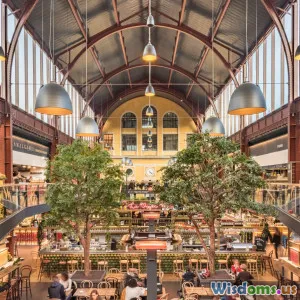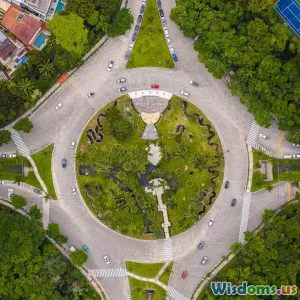
Gothic Cathedrals Were Technology Hubs of Their Era
9 min read Explore how Gothic cathedrals served as medieval technology hubs, blending engineering marvels, artistic innovation, and scientific knowledge. (0 Reviews)
Gothic Cathedrals Were Technology Hubs of Their Era
Introduction: Beyond Stone and Spirituality
Standing tall against the medieval skyline, Gothic cathedrals evoke images of spirituality, artistry, and devotion. Yet, to restrict these monumental structures to symbols of religious fervor alone is to overlook their foundational role as the technology and innovation hubs of their time. From revolutionary construction techniques to cutting-edge engineering principles, Gothic cathedrals represent the pinnacle of medieval technological advancement, merging architecture, art, and early science.
This article will journey through the intriguing confluence of technology and artistry that shaped these iconic edifices. By examining the ingenuity in their design, the knowledge systems behind their creation, and the human expertise involved, we’ll uncover how Gothic cathedrals were essential centers of innovation in an era we often dismiss as technologically primitive.
The Birth of Gothic Architecture: A Technological Revolution
Origins and Technological Context
Emerging in 12th-century France, Gothic architecture marked a dramatic departure from the heavy, solid Romanesque style. Architects sought to reach vertical heights previously unimaginable, opening up walls to light by replacing thick stone with soaring windows. This was not just an artistic flourish but a marvel of structural engineering.
Innovations that Empowered the Gothic Style
-
Pointed Arches: Unlike semicircular Romanesque arches, pointed arches redistribute weight more efficiently, allowing for taller and more slender structures. This development was likely informed by trial, error, and inspired by Islamic architecture encountered during the Crusades.
-
Ribbed Vaults: Ribbed vaults used diagonal stone ribs to support thin masonry panels. This innovation lightened the load and allowed for complex ceiling shapes, enhancing spatial dynamics.
-
Flying Buttresses: Perhaps the most iconic Gothic innovation, flying buttresses transferred lateral forces away from walls to external supports. This breakthrough enabled cathedrals to maintain expansive stained glass windows that flooded interiors with ethereal light.
These technological milestones demonstrate how Gothic cathedrals were not static monuments but dynamic experiments in pushing material and design limits.
Master Builders as Early Engineers and Project Managers
Constructing a Gothic cathedral was one of the most complex projects of the medieval era, requiring coordination across numerous disciplines.
The Role of the Master Builder
The master builder was the ultimate technologist of the time—architect, engineer, foreman, and project manager combined. They oversaw geometry, material procurement, workforce management, and often the sculptural programs as well.
Advanced Tools and Techniques
-
Geometric Knowledge: Builders used rudimentary yet precise geometry tools, including compasses and proportional rulers. Manuscripts like Villard de Honnecourt’s sketchbook reveal meticulous planning and early explorations in structural mechanics.
-
Material Science: Understanding the qualities of different stones, mortars, and timber was critical. Some cathedrals reused stones from Roman ruins, while others developed local quarrying techniques.
-
Measurement Systems: Units like the "toise" or "foot" were standardized for the project, enabling consistent scale and proportion throughout the massive construction.
Workforce and Knowledge Transmission
Thousands of craftsmen—stonemasons, carpenters, glaziers, and sculptors—were organized in guilds, each preserving and passing down trade secrets. This early intellectual property network resembles modern knowledge economies.
Science of Light: The Technological Artistry of Stained Glass
The spectacular stained glass windows of cathedrals are not merely decorative but represent a blend of scientific skill and artistic vision.
Chemical Innovation
Creating vivid colors involved pioneering glassmaking techniques:
- Adding metallic oxides like cobalt or copper to molten glass yielded brilliant blues and reds.
- Artisans controlled firing temperatures precisely to stabilize colors, a complex process not fully understood until centuries later.
Optical Effects and Theological Symbology
The windows not only brightened interiors but also told biblical stories, educating largely illiterate congregations. The interplay of natural light and colored glass created dynamic spiritual experiences—an early form of immersive technology.
Structural Calculations Without Calculators: Medieval Engineering Logic
Empirical Engineering
While lacking formal engineering science as we know it today, Gothic builders relied heavily on observation, scaled models, and iterative design:
- Loads and stress were tested on models crafted with timber or scaled masonry.
- Adjustments during construction were common, demonstrating adaptive management.
Recording and Sharing Knowledge
Although detailed blueprints were rare, sketches like those by Villard de Honnecourt and construction ledgers reveal an organized approach to knowledge sharing, highlighting how technology disseminated across regions.
Multifunctional Technology Centers: Beyond Construction
Educational Hubs
Many cathedrals hosted schools where mathematical, astronomical, and engineering knowledge was taught alongside theology. This intellectual ferment fueled wider medieval scholarship.
Urban Development Catalysts
The logistics of cathedral construction prompted advances in transportation (e.g., specialized carts, rudimentary cranes), commerce (quarrying and materials supply chains), and labor organization, laying foundations for emerging urban economies.
Early Mechanical Technologies
Some cathedrals incorporated mechanical clocks, carillons, and elaborate bell systems—precursors to modern machinery demonstrating a fusion of artistry and technology.
Case Study: Chartres Cathedral’s Technical Brilliance
Chartres Cathedral in France exemplifies Gothic technological mastery:
- Its labyrinth pattern on the floor symbolizes a spiritual and geometric complexity, possibly used for teaching and meditation.
- The flying buttresses efficiently distribute weight, allowing for over 150 stained glass windows that flood the interior with light.
- Conservation techniques applied during its centuries-long lifespan demonstrate early awareness of material preservation.
According to historian Paul Frankl, Chartres represents "the first true harmony between engineering demands and aesthetic aspirations," underscoring its pioneering synthesis of innovation.
Conclusion: Gothic Cathedrals as Medieval Technology Epicenters
Far more than religious shrines, Gothic cathedrals were vibrant centers where diverse medieval technologies converged—architecture, material science, optics, mechanics, project management, and education. Their construction demonstrated advanced problem-solving skills and a collaborative spirit akin to modern engineering projects.
These towering stone giants remind us that medieval society was far from technologically stagnant; it was, in fact, innovating within the constraints of its time to produce marvels of engineering and design that continue to inspire awe and study to this day.
Embracing the legacy of Gothic cathedrals invites us to recognize the enduring human drive toward innovation, creativity, and communal effort—values as vital now as they were eight centuries ago.
References:
- Paul Frankl, Gothic Architecture (1962)
- Rosemary Hill, God’s Architect: Pugin and the Building of Romantic Britain (2007)
- Villard de Honnecourt’s sketchbook (13th-century manuscript)
- Stephen Murray, Notre-Dame of Paris: The Biological Cathedral (2016)
- James Stevens Curl, The Egyptian Revival: Ancient Egypt as the Inspiration for Design Motifs in the West (2005)
Rate the Post
User Reviews
Popular Posts


















